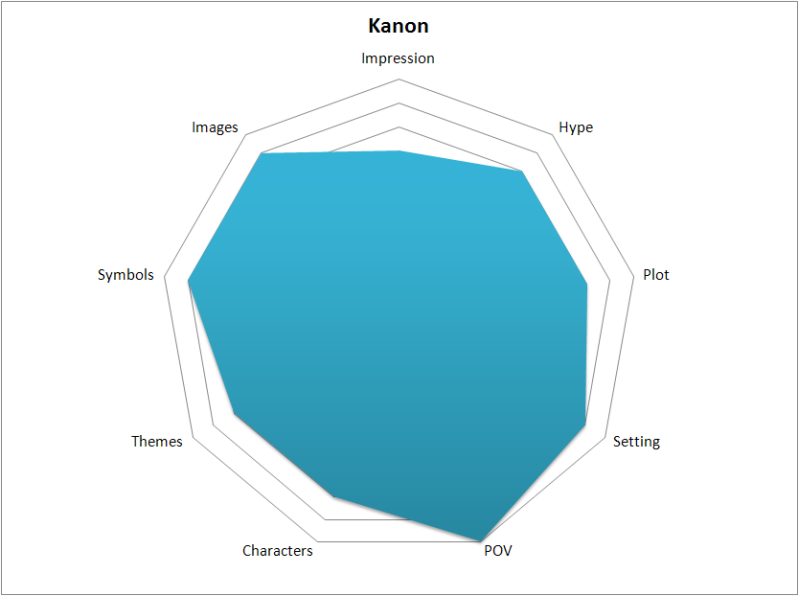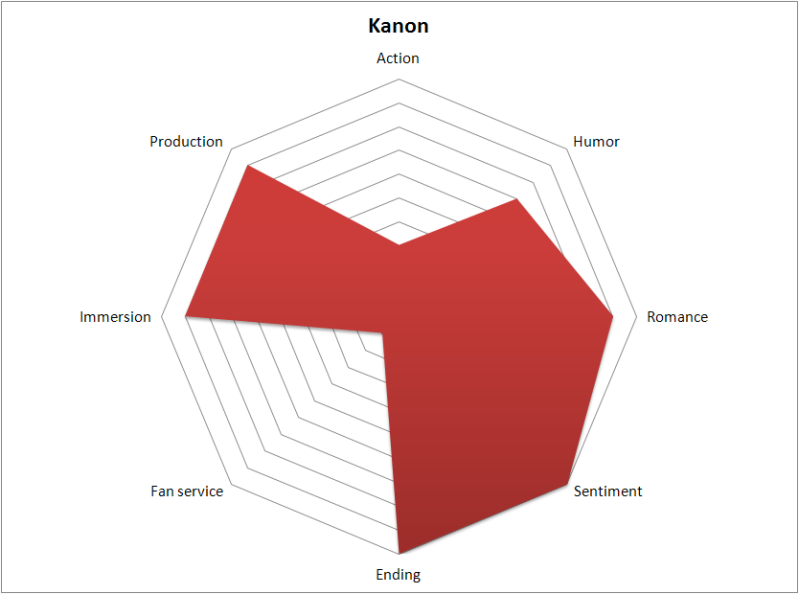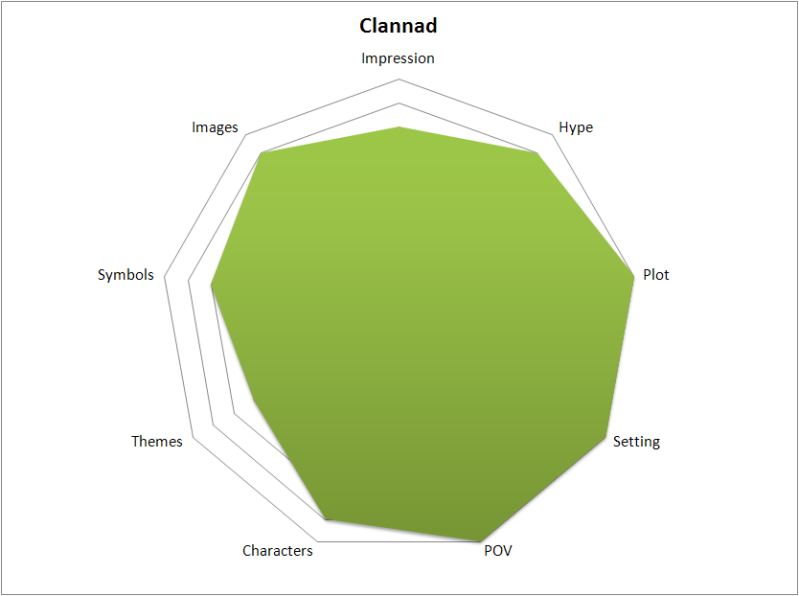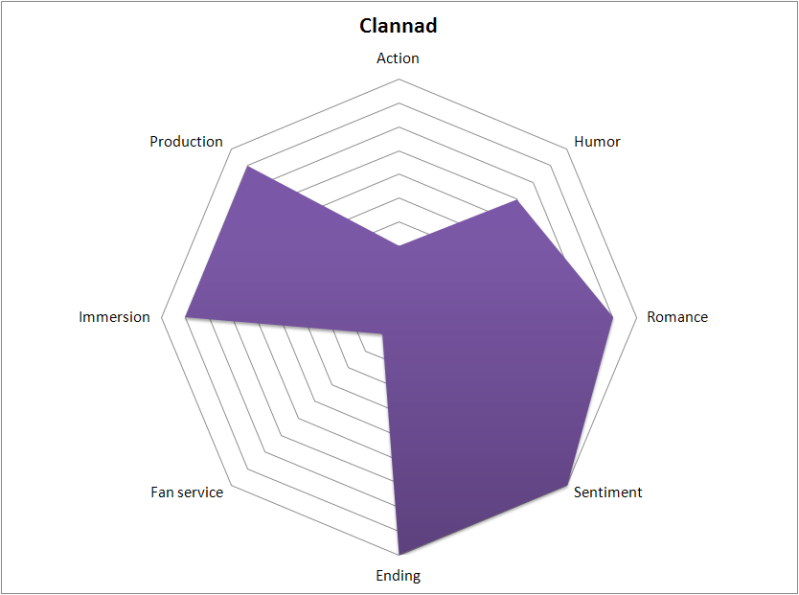Regarding
Ah so, I’ve been meaning to review Clannad and since I just finished up Kanon I figured it would be proper to review both animes simultaneously because:
- Both of these animes were produced by the same studio: Kyoto Animation
- Both of these animes are directly based on Visual Novels by Key
Clannad’s and Kanon’s fame isn’t mysterious as both anime series have experienced an incredible amount of popularity among the anime viewer-base. According to ANN, Clannad and Kanon both hold incredibly high ratings among anime fans (~ 9/10). It seems that Key’s imaginative writing staff and Kyoto Animation’s top-notch production values have produced what could be argued as the best anime ever!
Kanon
Introduction
Kanon was originally an eroge visual novel, but the main premise is nearly the same in the anime. The series is primarily focused on Yuichi Aizawa’s interactions with people he had already met in the past but couldn’t remember at the time. As you can tell, one of the central themes of this anime is the idea of memory and how amnesia plays a role in shaping the world. From what the audience is told in the anime, Yuichi transfers from some unknown place in Japan to yet another unknown place where the series is set in. The only things we know about the setting are that it’s very cold, snowy, and full of people who tend to lose their memories.
At the beginning of several episodes, the audience is shown a flashback about one of the characters interacting with Yuichi in some way. The pace of the series is expectedly slow and easy going. You’ll find that Key and Kyoto haven’t lost their touch when it comes to expressing the moe traits within the characters – with the exception that the tsundere appears no where in this series. You’ll quickly find that this series has only one male focus and several female supports, thus making this another lovely haremfest. And yes, the girls are cute.
Plot
Kanon is centralized around Yuichi and his interactions with former friends and his quest to remember who they are. At the beginning of the story, Yuichi finds himself at a train station waiting for his cousin, in the snow, to pick him up. She arrives several hours behind and asks Yuichi what her name is – to which Yuichi jests that her name is common and unmemorable. Of course, he closes the loop with her correct name, Nayuki.
The start of the series begins much like this encounter with his cousin, meeting old friends Yuichi can’t remember. In that sense, you can also perceive this as a slice of life anime – which it is sometimes – but we start to deviate from that genre once the anime begins focusing on the story of all the girls that Yuichi has met in the past.
A large part of the plot is conveyed through flashbacks realized at the beginning of an episode or during a dream sequence of the main character – they’re usually one in the same. In tandem with the flashbacks, and something I feel should be in the “theme” section, the series does its damnedest to emphasize the importance of following through on promises by echoing past events; several events in the series play out exactly the same – literally, word for word – as events in the past. I’ll get to the theme of “promises” later but I wanted to accentuate the animators’ relentless insistence of drawing motifs throughout the series; but what else is new (for Key)?
As with Key’s other works, the main character, Yuichi, has the most screen time of any other character in the series – lending the series to be a first-person narrative. This actually works out quite nicely as the rest of the cast would surely have been bland to watch – with the exception of Mai.
Speaking of which, you’ll definitely get a chance to see all the girls and their stories as Yuichi drives down memory lane with them all at one point or another in the series. There are approximately 5 arcs that consist of 4-10 episodes each. Now, I know you’re like,
“Whoa! Whoa! There’s only, like, 25 episodes in total”
But that’s just how it is. In fact, one of my favorite characters in the series has the shortest story arc in the entire series. Now, that’s all the details I’m willing to divulge as far as the plot goes; I’m not trying to rehash the experience of watching the series as that would defeat the purpose of this review.
Speaking of which, who the hell is Yuichi? But more importantly, who the hell are the girls?
Characters
I won’t go into detail about the characters and their role throughout the series – hell, I won’t even list them all; I’ll go ahead and list them and briefly cover their character.
- Yuichi Aizawa: The beloved, and surprisingly level-headed, main character with a familiar voice actor. And much like the other characters that Tomokazu Sagita has played, Yuichi comes right out of the gate cracking wise with his cousin and friends over the white blanket of snow. I must say, Yuichi is pretty lovable as the lead character in this series. He doesn’t carry any self-loathing and he’s quite charming. If you’ve ever seen The Melancholy of Haruhi Suzumiya and Clannad, you’ll definitely see qualities of Tomoya and Kyon in Yuichi; it’s unmistakable.
- Nayuki Minase: Yuichi’s cousin and loaded with moe goodness (or maybe gushyness?), complete with a set of cat ears formed by her long hair. Nayuki is probably one of my favorite girls in the entire series – and it’s not because she’s one of the prettiest, but because she’s so adorable. At first she came off rather bland and flat, but her character really grows on you. Somehow, the voice actress manages to take a monotonous run-of-the-mill anime girl and inject more moe gooeyness than you can handle. I especially like Nayuki’s sleeping habits; reminds me of how I use to sleep at Georgia Tech – oh wait, I never slept there.
- Mai Kawasumi: In every anime series, there’s always the girl who takes things really seriously – Mai is that girl. For some reason, I have such a weak spot for these types of girls, but maybe that’s because they need love too! What I’ve found is that the tsunderes have the mushiest sides – that’s probably what makes them so damn cute; Mai’s no exception. She’s absolutely heart-warming. Mai spends her nights at school killing demons, which probably would harden anyone. But her particular demeanor is that of a person who chooses not to speak – and if they do, it’s important and terse. In fact, she’s always being accused of vandalizing school equipment, but she refuses to admit or deny blame, which leads everyone to believe that she truly is the culprit (*cough* Our Country’s Good *cough*). Ahhh, but I’ve always been a sucker for the lonely (hot) girls who put up tough. Oh well.
Themes
I’d have to say that the greatest aspect of the series is its emphasis on several themes that are all connected by the very nature of memory – symbolized by the snow. As Yuichi makes his way into town for the first time in the series, we see that the weather has entrenched the city in snow. Upon the next morning, Yuichi wakes up in bed and asks of himself,
“Where am I?”
It’s no coincidence that the very first questions that the characters ask are ones about simple identity and location – and yet they don’t reveal the answers to the more fundamental questions the audience might be asking. It’s difficult to link the snow with memory loss until the end, but the snow symbolizes the layers of memory loss that have consumed the main character in his seven year absence. The landscape looks the same; smooth, white, and camouflaged. The setting isn’t very revealing; all the scenery’s landmarks are molded together into a blurry singularity. It isn’t until the end that we see the signs of joy as the sun rays melt away the amnesia of winter.
Together with memory, we have a loss of identity. Several of characters have no idea who they are or where they’re from. Makato’s amnesia has rendered her completely anonymous and Ayu doesn’t actually have a real name; Yuichi conjured a name for her based on the sound she was making while she was crying. Even Mai’s identity is suppressed and forgotten until the very end of her arc, where Yuichi reminds her of her true nature – resulting in her suicide. And perhaps even Kaori Misaka’s denial of her sister’s existence plays a role in how important identity is. The memories of Kaori’s past have pushed her to denying that her sister even exists; merely living a fantasy life without the pain of loss – a faux identity.
Along with memory is the idea of making and keeping promises in Kanon. The series reiterates the character’s promises to one another and emphasizes the importance of keeping them. The series especially focuses on the idea of “being there” and punctuality – something Yuichi constantly has trouble with throughout the series; this goes hand in hand with Yuichi’s inability to bring Ayu out of her coma.
Aside from the ones I’ve mentioned, I know that there are dozens of other themes that present themselves throughout the series, such as self acceptance, love, and food, but it would be impossible to go over all of them; hell, I couldn’t really pull of a thorough explanation of the major themes. Regardless, the anime is loaded with heavy material for everyone to ponder over and rivals its younger brother, Clannad.
Conclusion | Final Thoughts
Among all the different qualities in this series, I believe the most favorable is the main character, Yuichi. He really brings the magic of the series to the audience. And what’s more, Yuichi is calm, cool, and collected unlike many of the other male leads in other popular series (*cough* Naruto *cough*). Yuichi’s sarcastic tint brings in the humor that the series’ desperately needs to balance out the heavy somber note. But that doesn’t make him one dimensional; he convinces the audience of his anguish during the more melodramatic parts of the series. And behind the main character is a great lineup of supporting characters that melt the heart of the audience. Each one of the girls that Yuichi meets brings a gooey pot of moe goodness, complete with tragedy and humor.
Aside from the characters, the story is modular that makes extensive, albeit somewhat exhausting, use of flashbacks to fill in the blanks and keep the audience engaged. At times, it can be somewhat bewildering to figure out the relationship between the past and the present during some of the flashbacks; Kanon is a series that you should watch twice. And despite the story being modular, it would be best to watch it all from start to finish.
Although, I know that many people will find this series a bit too fantastic – as in fantasy based – for their liking, but I really enjoyed the story and the way it was presented. I actually walked into this series after I watched Clannad, which gave me the false impression that Kanon would be upbeat. It wasn’t a fatal mistake – actually, I just made a false assumption – but the series does take most people off-guard for being so drab; it actually works out quite nicely.
So for those of you who are in the mood for a slower and more somber anime that is rich in thematics, Kanon might just be right up your alley. There’s no doubt that this series deserves the praise that it’s received from critics and general audiences alike. Much like the next anime I’m about to review, Kanon is Anime – with a capital “A.”
Charts
Rating Chart:

Attribute Chart:

Score
Rating: 8.51 | ~85.1%
Interlude
Ah, OK! Now, I’m going to jump into the Clannad review. I know that this section seems a little extraneous, but I wanted to quickly jam this section in between the two reviews so that they don’t run together. Also, I want to remind you that the two animes were produced by the same companies (both the anime and the visual novels were created by Kyoto Animation and Key respectively. Ergo, Kanon and Clannad share many themes, qualities, and character prototypes. I’m only telling you this now, because you’ll find me repeating aspects about Kanon that are present in Clannad. I’ll try not to copy and paste (^_-).
And without further delay, here is the Clannad Review.
Clannad
Introduction
Much like several of the previous anime I’ve seen, Clannad is based on a visual novel by Key, but, unlike Kanon and several others I’ve mentioned, the visual novel is not an eroge. Key decided that they wanted to create a visual novel without any adult content in it and keep several themes – namely memory, fantasy, and identity. Several elements are borrowed from Kanon, and quite possibly Air (another visual novel by Key), but Kyoto decided to take Clannad in a different direction than Kanon; the somber mood of Kanon was done away with in favor of a brighter and more energetic one. But don’t mistake this series to be child’s play, there are some heavy moments in the series that make even the strongest people mushy.
Plot [Spoilers]
The series starts off with our winsome protagonist, Tomoya Okazaki, opening up the door to Clannad with the line,
“I hate this city”
Boy, does that put it in perspective. Actually, there’s a reason behind it all, but I’ll get into that later in the review. A familiar plot beginning, boy-meets-girl, joins Tomoya with his future wife, Nagisa Furukawa, at the foot of the hill leading up to their high school where a majority, if not all, of the first season takes place. From there, Tomoya joins forces with his adorable Nagisa and forms the Drama Club.
As Tomoya and Nagisa struggle to establish the Drama Club, several characters – females of course – come into play and a gooey haremfest ensues. Just like in Kanon, each character is dedicated several episodes of airtime to tell their stories; but unlike Kanon, we have 50 episodes to play with, not 25.
The first season of Clannad entirely revolves around the establishment of the Drama Club and the story arcs that highlight each individual character. We actually don’t see that many plot techniques being shown, with the exception of flashbacks for Kotomi’s arc. Unlike Kanon, I feel that Clannad Clannad “>was produced to focus on the themes of the story and not the actual events. Albeit, in the second season of Clannad, the authors decided to employ time-travel to bring about a happy ending. Furthermore, we see that there are two different and parallel settings acting upon one another; one in the primary material plane (Earth per se) and another in the “fantasy” world.
The primary material plane is where all the action really takes place. We see Tomoya and his harem of girls enjoying – Tomoya to a lesser extent – their life as we would normally expect. And then we see glimpses of the “fantasy” world, where a lonely girl is managing the happiness and memories of those in the primary material plane. Yeah…It’s kinda weird, but this plot device really adds a layer of depth to the story. Most fans most likely won’t actually recognize the significance of this “fantasy” world until they watch the series a second time – but it ties in really well at the end of the series, regardless.
The second season of Clannad really brings in the waterworks. If you don’t find yourself crying, or at least feeling some sort of sentiment, by the end of the second season, then you’re just not human. The second season focuses Tomoya and Nagisa’s life after high school. The couple gets married and tragedy strikes over and over. From here, we see a what a worn and beaten Tomoya becomes when he’s reached the edge of his patience. And this is where the themes of parenting and memory come into play. At the end of the second season, the main characters all go back in time; or rather the plane of existence is recreated in the image of a better world with happier people.
Characters
- Tomoya Okazaki: Our level-headed, albeit angsty, hero of the story. He’s your typical, always-late, easy-going student at the bottom of the student rankings; a “delinquent” as the Japanese put it. After his mother died in a car accident, he constantly argued with his father until it culminated into a severe physical fight three years prior to the story of Clannad where he injured his right shoulder. This prevented him from ever lifting his right arm above his head, shattering his dreams of ever playing on the basketball team. He has been an apathetic student ever since. He usually spends most of his time with his best friend, Youhei Sunohara, whom he relates deeply with; that is until he meets Nagisa.
- Nagisa Furukawa: The moe-ish sickly, weak, and helpless girl of Clannad. Nagisa is absolutely adorable and comes as one of the purest characters in the series. The story of Clannad focuses completely around Tomoya, but Nagisa becomes a dear part of his world. As Tomoya falls in love with Nagisa, we see that most of her dreams become the focus of the Tomoya’s direction in life. Although to be honest, Nagisa is one of my least favorite characters, but she’s a cute girl; some say that she was the perfect fit for Tomoya. And it seems that the authors at Key thought so as well, because Nagisa’s story arc has the longest and most involved set of events of any other girl that Tomoya can choose from. One of the reasons why I didn’t like Nagisa was because of the fact that she’s really static. Her character never changes throughout the entire series. The girl you meet in the first episode is the girl you leave in the last. Although, she builds up more confidence because of her encounter with Tomoya, but her principle character stays very much the same. And, it’s not because of this that I don’t like her as much as the others, but it’s just the fact that I think that she needs longer hair to really attract my attention ^_^.
Themes
As with most of Key’s work, Clannad is loaded with themes that speak about lofty ideas that most of us already take for talking-points in high school. With no attempt to hide the fact that Key likes to borrow themes from its previous works, Clannad displays ideas about the importance of memory and how it’s linked with identity, the importance of having dreams and realizing goals, and being a good parent by giving your very best. All of these things tie in at one point or another, but I feel that the themes of this series become rather ambient to the fantasia of raw emotion that floods the plot. I don’t want to dive deep into the themes, as that would probably be a joyless endeavor for both of us. I feel that perhaps the authors of this series wanted to focus on connecting the audience with the characters and their situations, rather than trying to project an idea on to the audience. As with most anime, the aim of the series is to entertain and engross, not to establish a new world order. Regardless, there’s a lot of sentimental points that this series makes that should pull on some heartstrings.
Conclusion | Final Thoughts
Clannad is by far one of the absolute best anime series on the market. This zephyr has brought me, as well as most fans, a nice reprieve from all of the supernatural, explosive action that I’ve been watching lately. To be honest, the slower pace of the series makes it more dramatic and easier for the audience to swallow. The characters are what you’ll love the most about this series – if not, then the situations the characters find themselves in. The main character and his group of friends are some of the easiest people to relate to and give this series a much different feel than most of the others out there. Somehow, Kyoto Animation managed to inject buckets of moe into this series without detaching the audience in the process. Albeit, there are some moments in the series where you find the mood somewhat overwhelming for the plot that’s associated with it, but, for some reason, it works. Clannad is one of the best anime series I’ve ever scene; it’s of the likes of Death Note, Code Geass, and 5 CM/s (an anime I plan on reviewing later). You can’t go wrong with this series.
Charts
Rating Chart:

Attribute Chart:

Score
Rating: 8.93 | ~89.3%
Pingback: [Wrap Up] Year 2009 « Anime Crunch